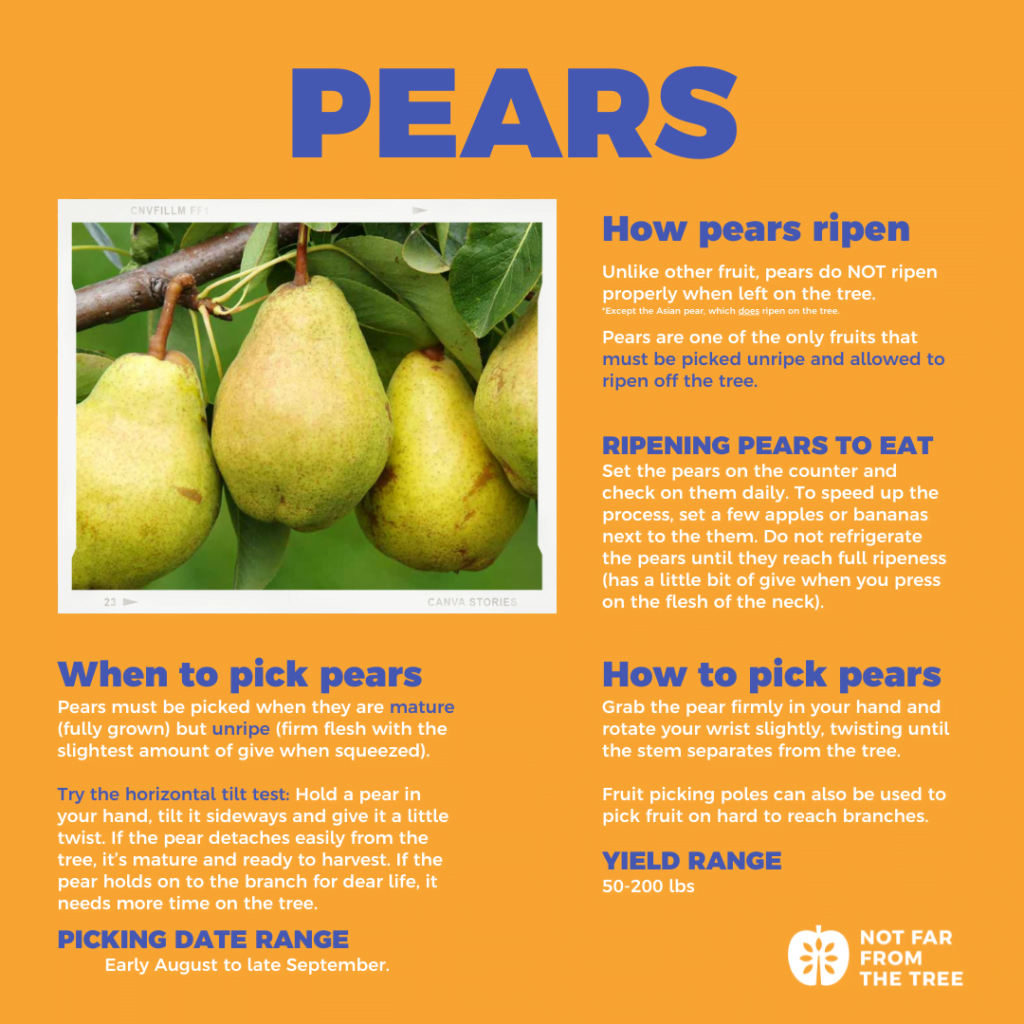In the intriguing world of fruit cultivation, pears hold a special place, admired for their luscious taste and delicate texture. Whether you have an orchard or a single pear tree in your backyard, the quest for perfect timing in harvesting this delectable fruit can be perplexing. Timing is crucial, as harvesting pears at the right moment can ensure optimal flavor and texture. In this article, we will explore the ideal time to harvest pears, considering factors such as variety, fruit size, color, and stem looseness. Understanding these key indicators will enable you to confidently pluck plump and juicy pears from the branches, guaranteeing a truly satisfying harvest.
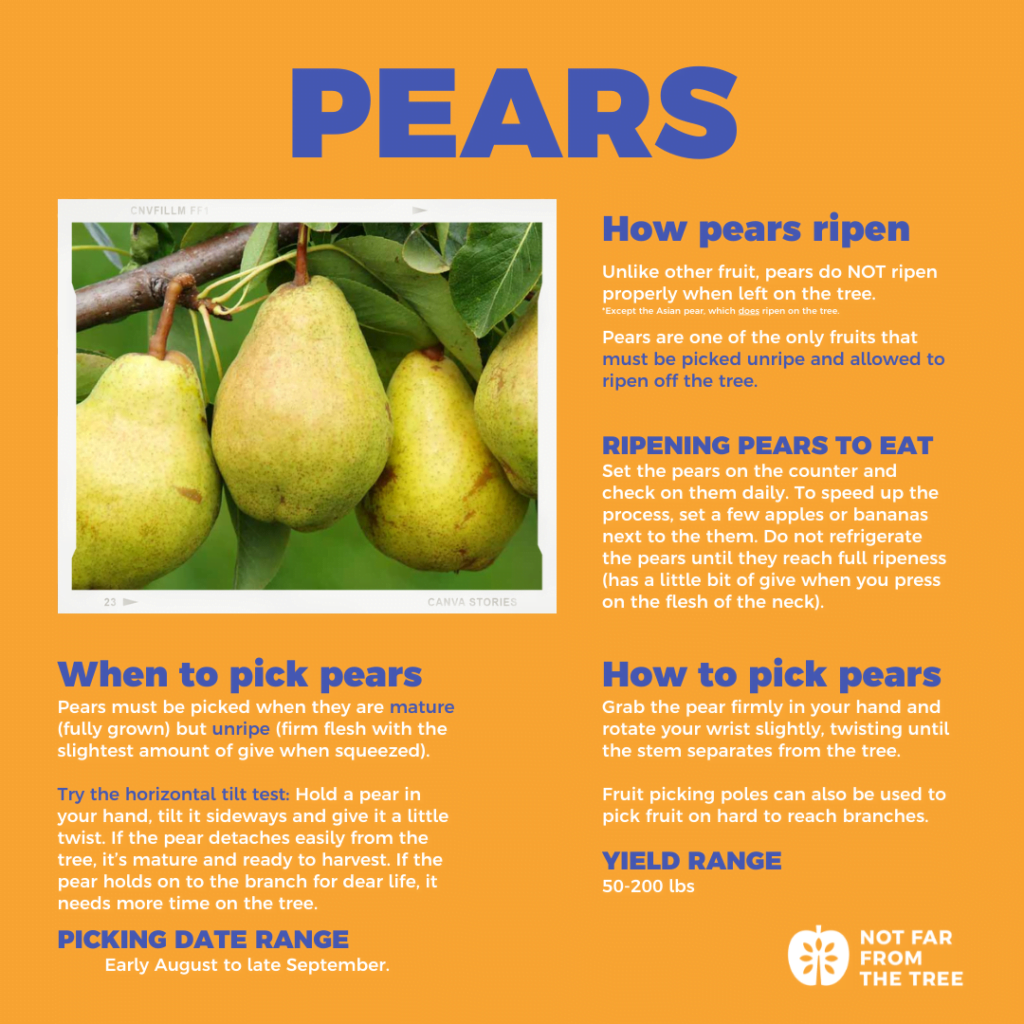
Factors to Consider
Harvesting pears at the right time is crucial to ensure the best quality and flavor. Several factors should be considered when determining the optimal harvest time for pears. These factors include variety, harvest time, color, texture, and taste.
Variety
There are several different varieties of pears available, each with its own unique characteristics. Some popular pear varieties include Bartlett, Anjou, Bosc, Comice, European, Asian, D’Anjou, Forelle, and Seckel pears. Each variety has its distinct flavor, texture, and ripening time. Therefore, understanding the specific characteristics of each variety is essential in determining the right time to harvest.
Harvest Time
The harvest time for pears varies depending on the variety. Each pear variety has its specific range of maturity, during which it reaches its optimum flavor and texture. Harvesting too early may result in underripe pears, while harvesting too late can lead to overripe or decayed fruits. It is important to know the appropriate harvest time for each pear variety to ensure the best quality product.
Color
The color of the pear’s skin can indicate its ripeness and readiness for harvest. As pears ripen, they undergo changes in color, transitioning from green to yellow or red tones. The degree of color change varies among different pear varieties. Some varieties, such as Bartlett pears, exhibit a significant color change when ripe, while others may have more subtle variations. By monitoring the color change, you can determine the appropriate time for harvesting.
Texture
The texture of a pear is another crucial factor to consider when determining its ripeness. Different pear varieties have varying textures, ranging from crisp and firm to soft and buttery. When ripe, pears should have a smooth and tender texture that is pleasant to bite into. Texture can be assessed by gently pressing the fruit and feeling for any firmness or softness.
Taste
Perhaps the ultimate factor in determining the harvest time for pears is the taste. Pears should have a well-balanced flavor that combines sweetness with a subtle hint of acidity. The taste of pears can vary depending on the variety, with some being sweeter and others more tart. It is recommended to conduct taste tests periodically to assess the flavor development and determine if the pears are ready for harvest.
Harvest Time for Different Varieties
Understanding the specific harvest times for different pear varieties is essential to ensure optimal flavor and quality. Here are some common pear varieties and their respective harvest times:
Bartlett Pears
Bartlett pears are one of the most popular varieties, known for their vibrant color and sweet flavor. These pears are typically harvested in late summer or early fall when the fruit is still green but starts to show a yellow or red blush.
Anjou Pears
Anjou pears are known for their versatility and juicy texture. They are usually harvested in mid- to late fall when the fruit loses its green color and turns a golden or yellow-green hue.
Bosc Pears
Bosc pears are characterized by their distinct elongated shape and russet-brown skin. They are typically harvested in late summer or early fall when the skin turns a deep golden-brown color and the flesh becomes firm yet slightly yielding.
Comice Pears
Comice pears are renowned for their buttery texture and sweet flavor. These pears are harvested in late summer or early fall when the skin changes from green to a pale yellow or creamy color.
European Pears
European pears, such as the Bartlett and Anjou varieties, are typically harvested in late summer or early fall. The harvest time may vary slightly depending on the specific cultivar and growing region.
Asian Pears
Asian pears are distinct from their European counterparts, known for their crisp texture and apple-like flavor. These pears are often ready for harvest in late summer or early fall when they develop a yellow or golden skin color.
D’Anjou Pears
D’Anjou pears are harvested in mid- to late fall when their green skin changes to a yellow or yellow-green color. These pears are known for their juicy and sweet flavor.
Forelle Pears
Forelle pears are small and have a distinct red speckled skin. They are typically ready for harvest in late summer or early fall when the green skin develops a yellow undertone.
Seckel Pears
Seckel pears are the smallest of all pear varieties and are known for their rich sweetness. These pears are usually ready for harvest in late summer or early fall when the skin turns from green to yellow or golden-brown.

Signs of Ripeness
To determine when pears are ripe and ready for harvest, it is important to examine several key indicators. These indicators include skin color, firmness, smell, and taste.
Skin Color
The color of the pear’s skin can provide valuable insights into its ripeness. As the fruit matures, it undergoes a color change, transitioning from green to shades of yellow, red, or brown, depending on the variety. Monitoring the skin color can help identify the optimal time for harvest.
Firmness
Firmness is an essential factor to consider when determining the ripeness of pears. Pears should yield slightly to gentle pressure when ripe but still maintain their overall firmness. By conducting a gentle squeeze test, you can assess if the pears have reached the desired ripeness level.
Smell
The aroma of a pear can reveal a lot about its ripeness. As fruits ripen, they emit a sweet and fragrant smell. The intensity and pleasantness of the aroma increase as the pears become riper. Carefully sniffing the stem end of the pear can provide insights into its readiness for harvest.
Taste
The taste of a pear is the ultimate indicator of its ripeness and flavor. Ripe pears should have a pleasant sweetness balanced with a subtle hint of acidity. Conducting taste tests by sampling a small piece of the fruit can help determine if the pears have reached their optimum flavor.
Skin Color
Observing the changes in skin color is an important aspect of determining when to harvest pears. Different pear varieties exhibit variations in color change during ripening.
Changes in Color
As pears ripen, the color of their skin undergoes transformations. Green pears gradually develop dashes of yellow, red, or brown hues depending on the variety. The intensity of color change can vary, with some pears showing a more significant change while others have more subtle variations. It is crucial to monitor these color changes to identify the ideal harvest time for each specific variety.
Variations by Variety
Different pear varieties exhibit distinct color changes during the ripening process. Bartlett pears, for example, shift from a deep green to a golden-yellow when fully ripe. Anjou pears, on the other hand, transition from a bright green to a yellow or yellow-green hue. Understanding the color variations specific to each variety is essential to ensure accurate determination of ripeness.
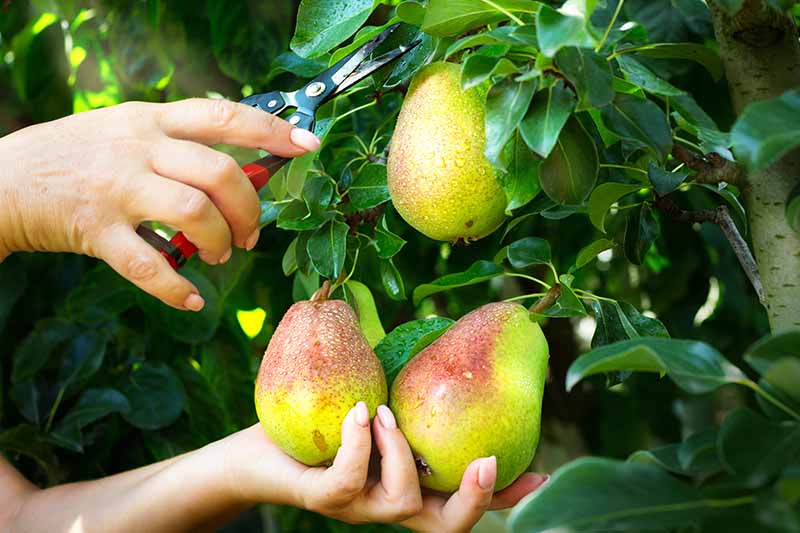
Firmness
Assessing the firmness of pears is a reliable method to determine their readiness for harvest. Firmness can be evaluated through a gentle squeeze test and varies by variety.
Gentle Squeeze Test
To check the firmness of a pear, gently apply pressure to the fruit using your thumb near the stem end. Ripe pears should yield slightly to the pressure but still retain their overall firmness. If the pear is too firm, it is likely underripe, while if the fruit feels mushy or overly soft, it may be overripe.
Consistency by Variety
Different pear varieties have varying levels of firmness when ripe. For example, Bartlett pears tend to have a slightly softer texture when fully ripe, while Bosc pears remain firm even when fully ripe. Understanding the consistency expected for each variety is crucial in accurately assessing the ripeness based on firmness.
Smell
The aroma of a pear plays a significant role in determining its ripeness. By sniffing the fruit, you can evaluate its fragrance intensity and characteristic scent.
Aroma Intensity
As pears ripen, their aroma becomes more pronounced and sweet. Ripe pears emit a fragrance that is enticing and pleasant. The intensity of the aroma can vary from subtle to strong, depending on the variety and maturity level. A fruit with a more intense and appealing scent is likely closer to its ideal harvest time.
Fragrance Characteristics
The smell of a pear can also provide clues about the variety and its flavor profile. Each pear variety has its characteristic scent, ranging from subtly floral to mildly citrusy. Paying attention to the fragrance can help in determining the preferred harvest time based on the desired aroma characteristics.
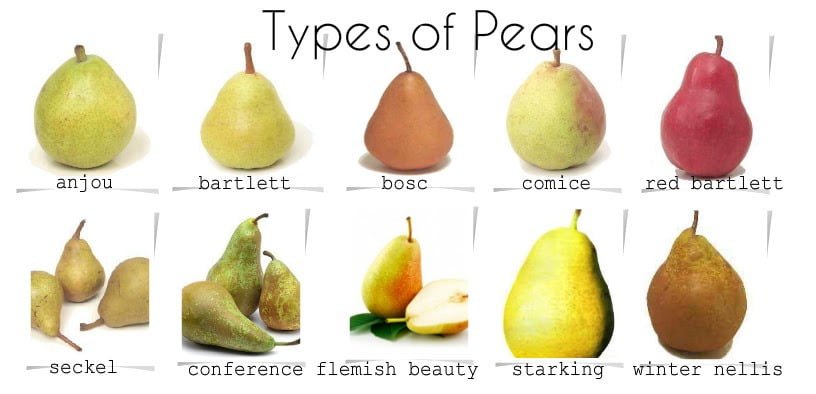
Taste
The taste of a pear is the ultimate test of its ripeness. To determine if a pear is ready for harvest, it is necessary to evaluate its juice, texture, sweetness, and acidity.
Juice
Ripe pears should be juicy and succulent. As pears ripen, they develop a higher water content, resulting in increased juiciness. Harvesting the fruit at the right time ensures an abundance of flavorful juice when consumed.
Texture
The texture of a ripe pear should be smooth, tender, and pleasant to bite into. The flesh should be neither too firm nor overly soft. Achieving the desired texture is crucial to ensure an enjoyable eating experience.
Sweetness
Sweetness is a key component of a ripe and delicious pear. Pears naturally contain sugars that develop and increase as they ripen. A well-ripened pear should have a satisfying level of sweetness that enhances its overall flavor.
Acidity
Acidity is another flavor component that complements the sweetness of pears. It provides a subtle tang that balances the sweetness and adds complexity to the taste. Ripe pears should have a delicate acidity that harmonizes with their inherent sweetness.
Harvesting Techniques
Once the optimal ripeness has been determined, it is essential to harvest the pears using proper techniques to ensure minimal damage and preserve their freshness.
Gentle Twist
One commonly used technique for harvesting pears is the gentle twist method. To harvest the fruit, firmly hold the pear near the stem and give it a gentle twist. If the fruit detaches easily from the tree, it is ready for harvest.
Vertical Lift
The vertical lift technique involves lifting the fruit vertically upwards while gently twisting it at the same time. This technique helps detach the pear from the tree without causing any damage or stress to the branch or fruit.
Proper Handling
After harvesting, it is crucial to handle the pears carefully to prevent bruising or any physical damage. Pears should be cradled in your hand or placed gently in a container to minimize pressure or impact that could lead to bruising.
Avoiding Bruises
Bruises can negatively impact the quality and shelf life of pears. It is important to avoid dropping or mishandling the fruit as much as possible. Care should be taken during transportation and storage to ensure that the pears remain intact and free from any bruises or damage.
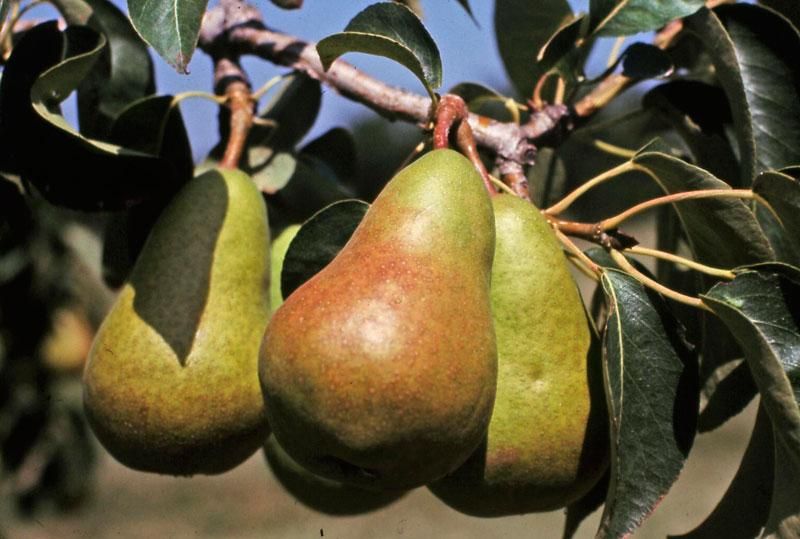
Conclusion
Harvesting pears at the right time is crucial for achieving the best flavor, texture, and quality. By considering factors such as variety, harvest time, color, texture, taste, and employing proper harvesting techniques, you can ensure that your pears are picked at the peak of perfection. Whether enjoying pears fresh or using them in various culinary applications, harvesting them at the optimal time will enhance your overall pear experience.
